Samsung Q60A Reviewed at $850.00 (55")
Product Name: Samsung Q60A
Product Description: 2021 4K QLED TV
-
Design - 9/10
9/10
-
Video Quality - 8.4/10
8.4/10
-
Ports & Connectivity - 8.4/10
8.4/10
-
OS, Apps and Features - 9.5/10
9.5/10
-
Price / Quality - 8.8/10
8.8/10
Summary
Reviewed at $850.00 (55″)
Pros
- Very nice and thin design
- Good color reproduction
- Low input lag
- Tizen
Cons
- Mediocre brightness
- Sub-par viewing angles
- No HDMI 2.1
- 60Hz panel
Cheapest Places to Buy :
*We are a reader-supported website. When you buy through links on our site, we may earn a small affiliate commission at no extra cost to you. Home Media Entertainment does not accept money for reviews.*
When it comes to Samsung and their 2021 lineup it was natural that all eyes would be turned to their new mini LED technology and the units that come with it. Obviously Samsung would use this technology only in their premium lineup but it seems that not all QLEDs will get the mini LED love as the lower-tier units will continue to use the same backlight tech they used the previous years. And one such TV is the Q60A and in our Samsung Q60A review today we will be testing this new release that is meant to replace last year’s Q60T.
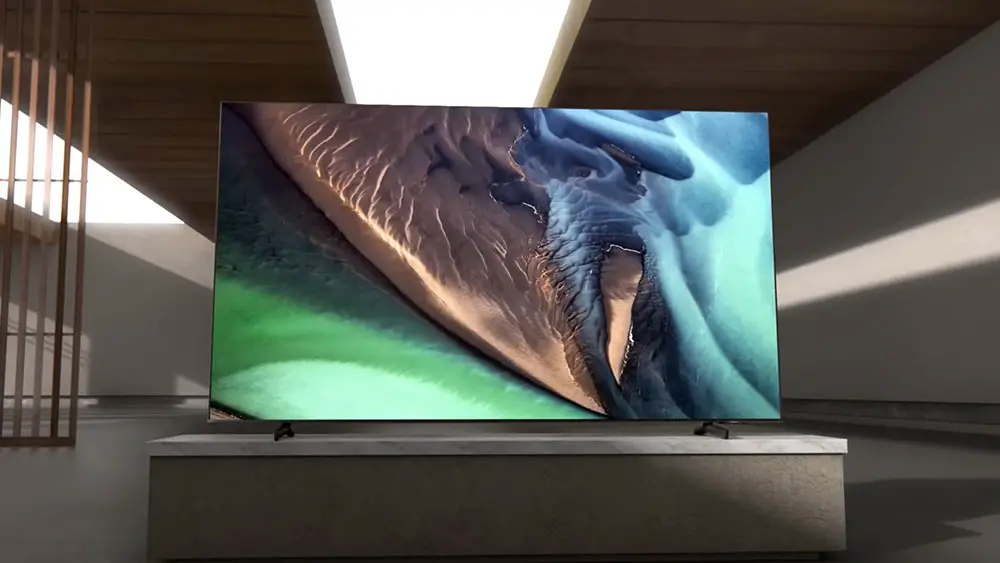
The Q60 models were really more of a fill up release than a real QLED as they were always missing many features and technologies that the other QLEDs always had and because of this the 60 models felt like they were created only to bridge the difference between Samsung’s Crystal series with the higher tier QLED units. But with a staggering 8 different sizes for the US market and 6 for the UK/EU markets it seems that Samsung believes there is high demand for this model as it manages to combine good price with a few more advanced features that the QLEDs have.
When looking at the specs the Q60A seems awfully similar to its predecessor, the Q60T. As such we still find a Dual LED backlight system with the same Quantum Processor 4K Lite handling all processing duties. There is also a 60Hz panel with Quantum Dot technology but sadly this is the only of the QLEDs with no HDMI 2.1 ports and goes for the old HDMI 2.0 instead. Upon first inspection other differences include a slimmer design, a redesigned remote, the inclusion of Object Tracking Sound Lite audio system and the new 2021 Tizen.
From the above it seems that for the Q60A Samsung didn’t make any drastic changes. They took the 2020 Q60T, changed and added a few features and slapped the new Q60A name on it. But is this enough for this unit to stand against what the competition offers in 2021? Let’s take a closer look to find out.
Design
The first obvious change we find in the Q60A is the design and while the unit seems to be using practically the same panel, Samsung have managed to shrink its thickness and make it a vastly better looking TV. Comparing the two units side by side shows a big improvement as the new Q60A has a total thickness of just 1.57″ (4.0 cm) and manages to keep this thickness across most of its body height. As per usual a slight curve is used at the very top but due to the thinner design this is far more subtle than it was in the Q60T.
The back of the TV is also different although the changes are not so drastic here. The entire back face is covered in a brushed texture plastic, as per usual with most Samsung models, while it seems that the inset that houses all ports on the left side along with the special grooves under it for cable management have slightly moved higher in order for the stand legs to fit below them. Everything else is the standard with the power connector on the right side and only the VESA holes visible for wall mounting.
The stand that comes with the Q60A is also different not only in design but also in functionality. We still get the usual bench type design which requires bigger furniture and is still made out of plastic but what is different here is that for the first time we see such a design that you can manage its height. This means that the TV can sit lower than what the Q60T could but also can go higher in case you have a soundbar and want to place it directly underneath the TV. A really smart design and surely will be appreciated by many.
The stand doesn’t have any special grooves for cable management but at least plastic clips that attach at the back of the feet are provided to keep all cables together. Another small and mostly cosmetic difference is the reposition of the Samsung logo with the built-in controls to the right side of the front panel something we also saw in the new QN90A so it seems that Samsung will go with this design for their new 2021 releases.

For 2021 it seems that Samsung decided to make a facelift on their One Remote and while fundamentally it’s the same one we have seen the last few years we do find some noteworthy changes. The remote is exactly the same as the one we saw in our QN90A review so it seems that all QLEDs are getting the new design this year. First of all its shell is still made out of plastic but has been redesigned and frankly it looks more premium now than before. Buttons layout has remained the same as last year but the big change with this one is that it doesn’t use disposable batteries. Samsung has included a solar panel at the back for charging or alternatively by using the included USB-C cable.
No other changes as we get the same built-in microphone that you can use in order to issue voice commands, it has the same HDMI-CEC functionality as it can act as a universal remote for other devices while it can also be used even if there is no support for HDMI-CEC. In general the remote got some cosmetic changes while the inclusion of a rechargeable battery is an interesting one even if not everyone will like it.
The Q60A is a really nice TV. The shrink in thickness and the new “AirSlim Design” as Samsung calls it, vastly improves its looks. The feet have more practicality as they have adjustable height while the new One Remote is a nice one. Quality of materials is practically the same and as Samsung got us used in this price category.
Video Quality
Processor technology used
In terms of processing power the Q60A seems to be borrowing the same silicone we saw in the Q60T last year which is a bit disappointing. The Q60T didn’t get the better Quantum Processor 4K either but with the new Neo Quantum Processor 4K this year you would at least expect to get the one that the higher QLEDs were using last year. Instead we get Quantum Processor 4K Lite once again making the gap between the Q60A and the rest of the QLEDs even bigger in this regard.

Now Samsung has not provided any details on what this “Lite” version has in comparison to the more advanced versions but from what we have seen the Q60A is not using the same AI algorithms for it’s image upscaling. This means that while this unit can upscale any lower resolution image in 4K this is not done in the same efficient way.
As we always do in our tests we tried some Full HD as well as SD content and to be honest we didn’t see any major problems with the upscaling process. All images rendered very nicely without any visible or distracting artifacts which shows that even this Lite version of the Quantum processor is still very capable in this regard.
As for the sound the Quantum Processor 4K Lite offers Object Tracking Sound Lite and Adaptive Sound. But more on these on the dedicated audio section below.
Lighting technology used
All eyes are turned to the new mini LED backlight system and not without reason. For a long time LCD TVs were limited by the backlight systems they were using and the new 2021 models bring something fresh to the table. But not in the Q60A. The TV is basically borrowing the same system we found in last year’s Q60T and is what Samsung calls a Dual LED backlight system with no local dimming.
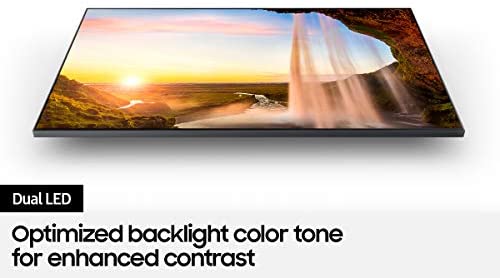
This means that the Q60A instead of having the LEDs behind the panel there is an array of LEDs on the top and bottom of the screen. This type of backlight is cheaper to incorporate and thus is used in the lower tier models but as a result we get less light control and precision compared to a FALD system that was the top performing system until last year.
But while the Q60A is fundamentally using an Edge lit system from 2020 Samsung seems to have made some tweaks to it in order to improve, in theory at least, the final result. Samsung calls it a Dual LED system which uses two different LED colors and adjusts the color tone according to the image being displayed. Additionally there is no local dimming that could further help with the weaknesses such a system has.
Other than that this type of system comes with the usual advantages and disadvantages. On the positive side TVs with such a system tend to be slightly thinner but on the opposite side we tend to see strips of light from top to bottom when a bright object is displayed on the dark background.
With the Q60A being so alike to the Q60T it was obvious that it would also get the less capable Dual LED system. Unfortunately if you want a TV with a far better FALD system not even the next model in line, the Q70A, has it and you will have to go as high as the Q80A to get it making the price much higher as a result.

Brightness / Contrast
Brightness is one of the most looked aspects of any TV nowadays as with HDR content the need for high brightness output is bigger than ever. For this specific part of our review we used the Movie mode and Warm 2 color tone along with max brightness. In our SDR brightness test over a 10% white window we got 448 nits which is more than enough for any kind of SDR material. On our HDR brightness test over a 10% white window we got 460 nits of brightness which is average at best and cannot really portray HDR in all its glory.
In terms of contrast the Q60A comes with a VA which means good things in general. But what surprised us here is that while in general contrast was good it seemed that it was slightly worse than what we had seen in the Q60T without having any indication why this was happening. And as the TV doesn’t have any local dimming functionality we were slightly disappointed with how the Q60A performed here.
Overall not much change in this part of our tests. Brightness was more or less the same while contrast was a bit worse than last year.
Viewing angles
As most TVs from Samsung, the Q60A is using a VA panel and as a result the viewing angles are not that good. And to make matters even worse this model is not equipped with the same Ultra Viewing angle technology that we find in some of the top-tier units that helps a little with this problem.
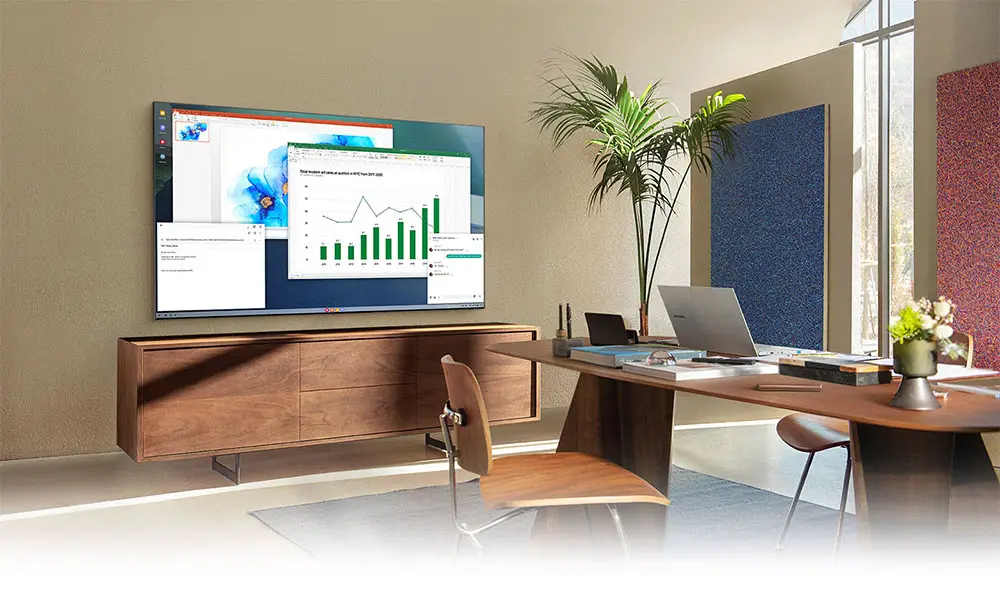
As a result the Q60A has very mediocre viewing angles. We could say that the maximum angle that image integrity was kept was around 25 degrees or slightly above that. But at anything more than 30 degrees and the image would start to degrade very much to consider it watchable. So you should consider this if you want this one for family use or if you plan on watching from various angles.
HDR support
HDR support is another area where Samsung has included the same across their whole TV range. As such we get the most basic HDR10 that is required for 4K UHD playback, there is HLG that is used mainly for broadcasting along with the newer HDR10+ which is the most advanced HDR protocol that uses dynamic metadata in order to provide the best image quality on a frame by frame basis and is the main rival of Dolby Vision.
Samsung continues to say no to Dolby Vision and this is another low point this TV surely has. All Samsung TVs hurt from this omission and it’s a real shame to see this war keep going like this.
Color coverage
The Q60A is the last of the QLEDs which means is the last model that uses Samsung’s special Quantum Dot layer in order to display more vivid and lifelike colors. And this is probably the only reason why the Q60A is rated as a QLED unit as most other specs are mostly downgrades in comparison. And while Samsung claims 100% coverage of the DCI-P3 color space we know that this is not entirely true as it is used mostly for marketing purposes, as is in most cases.
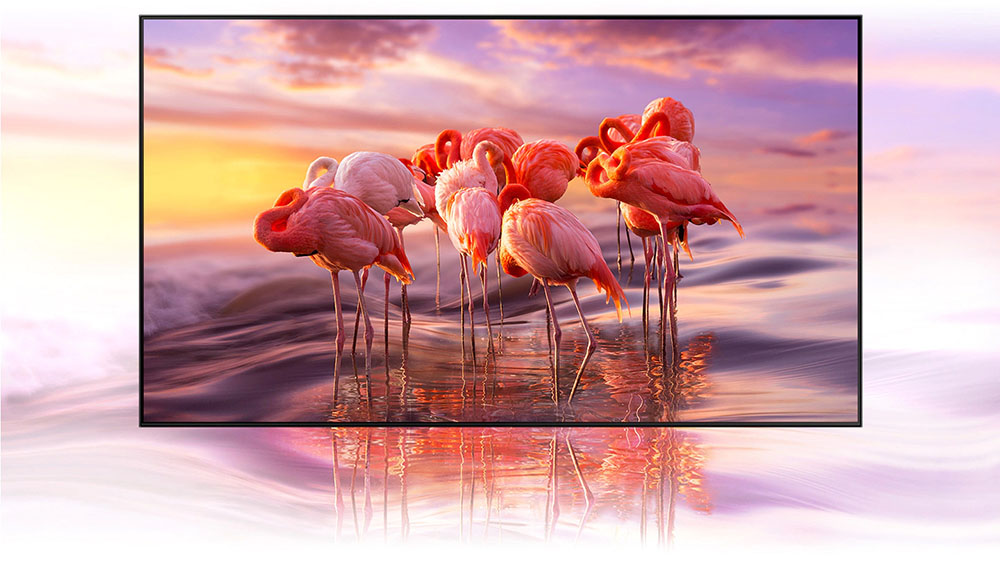
According to our measurements the Q60A has about 92% coverage of the DCI-P3 color space which is exceptionally good for it’s category. On the wider REC.2020 color space we got a coverage of 71% which is very good even if not as good as some other releases. From these numbers we see that the Q60A is a clear improvement in terms of color reproduction compared to last year’s Q60T.
Motion performance
Next is our motion performance tests and the Q60A seems to come with a 60Hz panel along with a backlight dimming frequency of 480Hz which is a bit different from what the Q60T had last year. Having such a high frequency ensures that flickering is completely invisible but this also depends on the picture mode you will be using as depending the settings the frequency can drop even as low as 60 Hz.
Obviously we also get motion interpolation which Samsung has renamed this year to Motion Xcelerator which is the most basic variant Samsung has this year. The Q60A was good enough at removing judder but this was also very much dependent on the scene. When there was crazy action some artifacts would become more than obvious.
Enabling motion interpolation can be done by going in the Picture Clarity settings in the menu and by adjusting the judder slider as much as you like it. Very high value and the “Soap Opera Effect” will appear but keeping a very low value like 1 or 2 seems to be good enough without any major alteration to the overall motion presentation. Keep in mind that there is no blur slider here as some higher tier units offer and thus overall the Q60A is more limited in what it can do with motion.

Black Frame Insertion (BFI) is also available as usual which can be enabled in the menu with the LED Clear Motion option. BFI is a technique that inserts a black frame in between two individual frames in order to smooth out motion. Although the end result is very good it has a couple of side effects. First due to the black frames brightness takes a visible hit while due to the lower frequency used some flickering may become noticeable.
The Q60A does not support any kind of VRR technology. If you definitely want VRR you will have to go for a more expensive unit unfortunately. Overall the Q60A is not much different than what we had seen in the Q60T last year. There are slight differences but looking at the whole picture we would say that performance wise they are very close to each other.
Input lag
In our input lag test now and the Q60A gave us the kind of numbers we were expecting. With Game mode turned on we got 10.3ms average for 1080p and 4K resolutions which is just about the same with what we had measured last year in the Q60T. With so low input lag even if you are a hardcore gamer you will have no problem whatsoever with your gaming sessions.
Outside of Game mode things are not so clear cut as different modes tend to give different results but in general we got an average of 71ms which is still good enough for casual and offline gaming where rapid response is not so crucial. This number is slightly better than what the Q60T could do outside Game mode. The TV also comes with Auto Low Latency Mode (ALLM) and all the latest consoles support this which can be of great benefit.
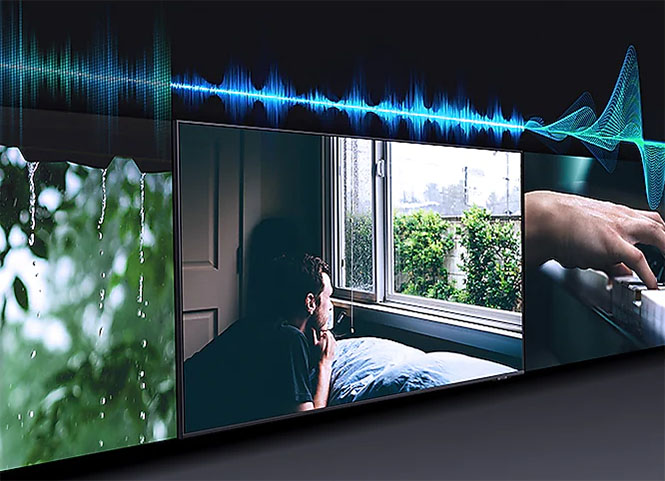
In order to get a taste of how these 10.3ms translate into the real world we tried out both Call of Duty WWII and F1 2019 in our PS5 and with both games we had an amazing time really. We didn’t notice any kind of delay between our commands and TV response and everything felt instant and butter smooth.
Image quality impressions
The Q60A is not that much different from last year’s Q60T. There are a few areas where we see some improvements like in the color reproduction but on the other side contrast seems to have gotten worse. In most other areas like upscaling capabilities, brightness, viewing angles, motion performance and input lag the numbers were very close to last year so we would say that the Q60A is more or less the same TV we got last year.
Audio Quality
Manufacturers have tried the last few years to create audio systems that improve the overall audio signature of their flat TVs. Some fare better than others but most of them are not suited for anything more than casual viewing. Samsung’s proprietary system is called Object Tracking Sound and as with many other features they scale it according to the price of the TV on offer.
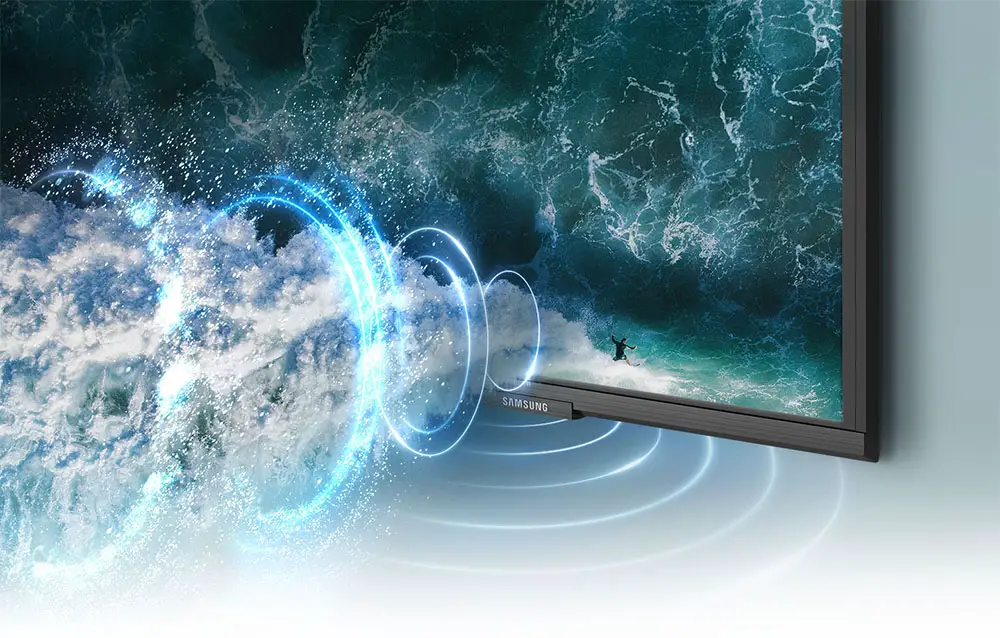
Last year the Q60T didn’t use that system and had to settle for a conventional 2 channels audio system that is the most usual we see in flat TVs. For 2021 it seems that Samsung decide to try and improve this and while we still don’t get the fully fledged OTS system at least we get some short of it which is called “Object Tracking Sound Lite”.
What this “Lite” version has different is that while both OTS and OTS+ systems use more speakers at the sides and top of the panel in order to track the sound according to what is displayed the one we have here is using a set of virtual speakers at the top in parallel to the two real speakers at the bottom. Obviously the result is not the same as having real drivers and we would say that while the Q60A can perform slightly better than a conventional 2.0 channel system it was not as good as the other TVs with OTS or OTS+.
Just for the record the Q60A is equipped with a 2.0 channels system with a total of 20 watts of power and in parallel with the Object Tracking Sound Lite audio system you get sound that feels slightly more fulfilling and more immersive but not as good as we know that this system can do by using more speakers.
The TV supports Dolby Audio but there is no native Dolby Atmos. At least you can pass-through Dolby Atmos through the included eARC to some Dolby Atmos soundbar or dedicated sound system. DTS support is completely absent once again this year as it is not only missing from native support but it cannot also be passed-through from any of the available ports. Samsung has completely dropped DTS support which is a shame really.
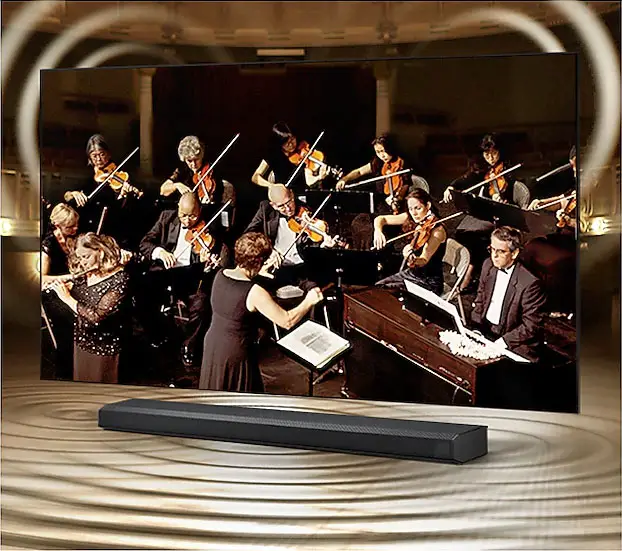
A feature that finds its way from last year is Adaptive Sound. Keep in mind that there is also Adaptive Sound+ that is being used in the more expensive models and is a more advanced system of the one we get here. With Adaptive Sound the TV can automatically make adjustments for the best sound experience possible according to what content is viewed at each specific time.
Lastly we get Q-Symphony which is a feature that you can use to combine the TVs audio system with an appropriate soundbar that also supports that. This way the audio will be synced and output from both devices for an even more immersive audio experience. Samsung has released a whole lineup of soundbars that support this feature in case you are thinking of getting one. Last year the Q60T didn’t have this so this one is an added feature in the Q60A for 2021.
Overall the Q60A feels like a small upgrade in the audio department over the Q60T. The inclusion of the Object Tracking Sound Lite system along with the addition of Q-Symphony that was missing last year makes the Q60A the better TV here even if not by a large margin.
Ports and Connectivity
Next we will be looking at what the Q60A offers in terms of connections. It seems that the redesign of this unit also brought a change in the ports layout compared to the Q60T.
Let’s start from those looking sideways and here we get 2 USB ports for connecting external storage devices along with a couple of HDMI ports and an Ethernet port between them for wired connection to a local network. There is also the usual antenna port on the bottom end of this section. Next to these we get another HDMI port and a Digital Audio output that looks backwards.
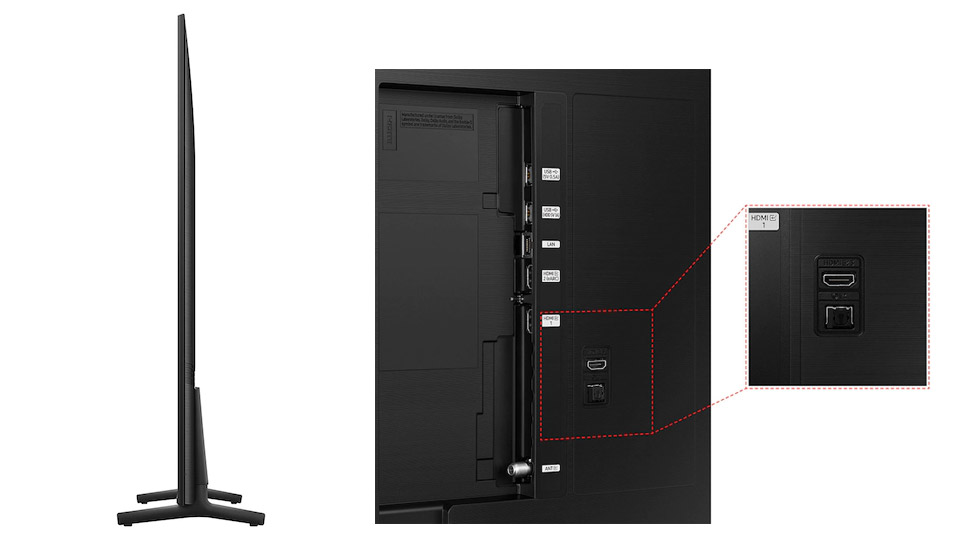
The differences we find compared to last year is that Samsung has moved the Ethernet port to the sideways looking group of ports while they completely removed the composite video input along with the analog stereo input. We see a trend forming where manufacturers are slowly phasing out the analog ports in their products which will certainly find some consumers with older equipment against it. As it is right now the number of TVs with analog ports is shrinking more and more and for 2021 it seems that there is not a single Samsung QLED that offers any analog inputs.
Unfortunately the TV does not support the new HDMI 2.1 ports and uses the older HDMI 2.0 instead. Also the USB ports are the older v2.0 which is not all that surprising to be honest. At least we do get eARC support which allows you to send high-quality object-based audio like Dolby Atmos to another device and is another handy feature that many seek nowadays.
As for it’s wireless capabilities the Q60A comes with the usual built-in WiFi and also with Bluetooth that is still the older v4.2. At least with Bluetooth we were expecting a newer version but it seems that all Samsung TVs still use the older 4.2 version.
OS, Apps and Features
The Q60A comes with the latest version of Samsung’s Tizen but seems to pack slightly less features compared to the top tier units in the same fashion last year’s Q60T did. There are not major differences here compared to what we saw in the QN90A for example but let’s see what is on offer.
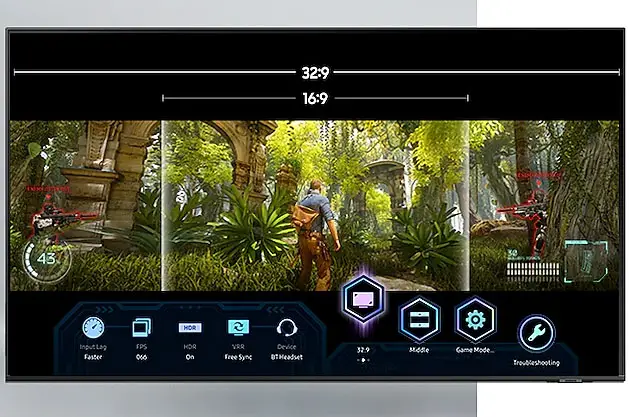
The 2021 version of Tizen is highly similar to previous years and the visual appearance of the new 2021 is no different from last year. Samsung retained the more dark visual design but this is purely an aesthetic thing and functionality remains as good as ever.
The general layout has remained completely the same with the launcher bar sitting at the bottom of the screen while a second row appears on top and offers several selections that include additional content and various suggestions. Customization couldn’t be missing as with so much content available it can become increasingly difficult to navigate through the apps and services especially if you use many of them at the same time. Tizen offers many customization options so you can re-arrange everything to your liking.
The first real addition this year is the Super Ultrawide GameView & Game Bar. This is an on-screen menu that lets you make real-time adjustments to screen ratio, input lag check, FPS, HDR, wireless headset settings and more. This can be a really handy feature to gamers as you don’t have to mess with menus every time you want to check on a specific setting. With this quick feature you have everything in front of you with the click of a button.
When it comes to content the Tizen platform is famous for it’s enormous support from developers. The Q60A offers practically all known services and platforms you can think of with Netflix, Apple TV, Disney Plus, Youtube, Amazon, Hulu, Rakuten, Demand 5 and BBC iPlayer just a few of the big names available. There is also Samsung TV plus which offers hundreds of subscription-free channels to choose from. Many of these services can playback in both 4K with HDR like Netflix and Amazon while in general navigating through several services felt smooth and without any noticeable lagging.
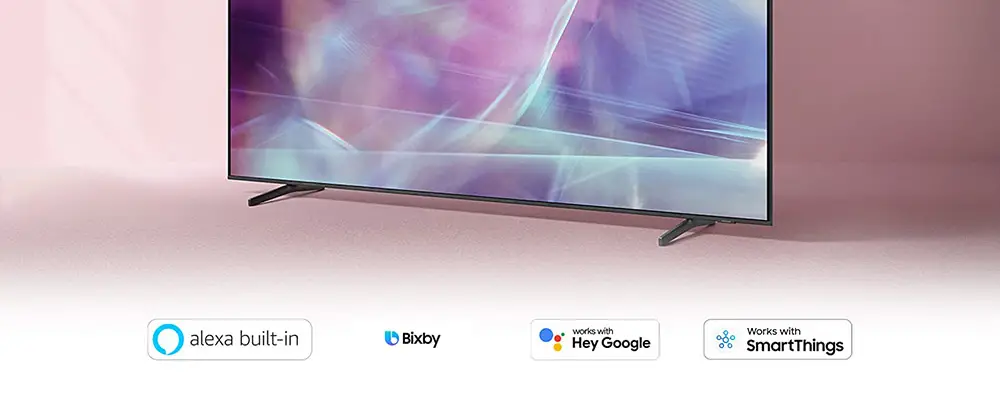
But if having so many apps available can be increasingly difficult for you then you can use a handy feature called “Universal Guide” which is another feature that make its return from last year. This is a feature that analyzes your viewing patterns and creates a ‘For You’ page that includes content you may be interested in seeing according to your viewing habits. So in case you are watching a specific series all the time this page can propose you to see the next available episode which can be a rather practical feature.
Moving on for one more year we get SmartThings integration. With it you can make your TV the central hub of all your smart houses devices. These can be lights, electronic locks, alarms, vacuum robots, thermostats and everything that supports the SmartThings platform.
Obviously another feature that could not be missing is voice control. It seems that Samsung is really trying to market their own Bixby service but even if you are not very fond of that there is Amazon’s Alexa or Google Assistant to choose from. While if you are an Apple guy then don’t get disappointed as there is also Airplay support and you can use Siri through it for your voice commands.
One feature that we saw for the first time last year and makes a comeback is Multi-View and although at it’s core it’s not something entirely new Samsung took it a step further. Multi-View is basically a more advanced screen mirroring and with it instead of just simply projecting the screen from your mobile device on the TV you can choose to have two screens showing both TV content and what your mobile device shows. How useful this can be we leave it to you to decide because we are still scratching our heads for this one.
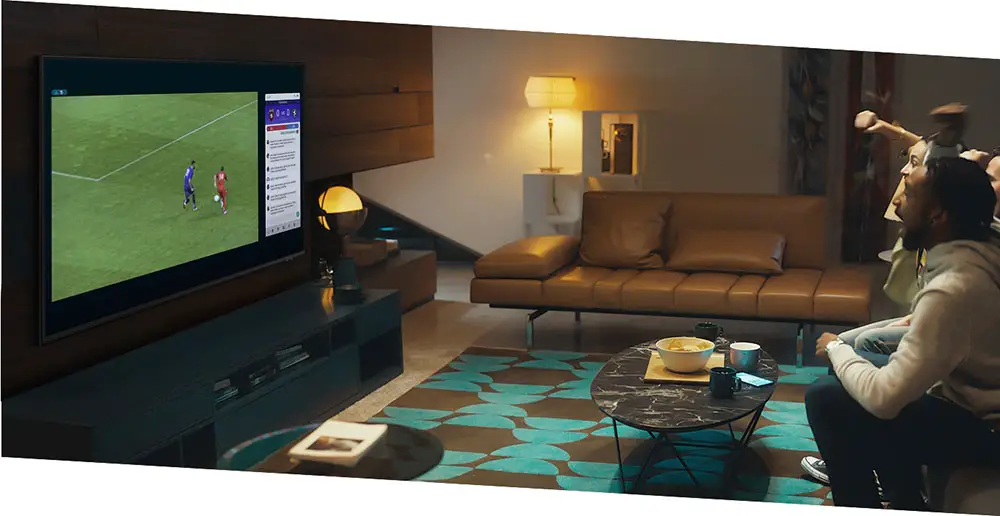
In addition to Multi-View there is also Tap View and with it you can mirror your phone on your TV with just a tap to continue enjoying movies, music, and apps on the bigger screen within seconds.
The Q60A also comes with Ambient Mode which seems to have become the standard in less expensive units lately. Keep in mind that this is the simple and not the plus version we saw in the QN90A and as a result comes with less functions available.
Lastly we have one more new addition this year and this is Samsung Health. It seems that with the coronavirus pandemic and many people staying indoors Samsung thought that exercise at home would become more popular. So many of their TVs this year come with Samsung’s program in order to stay in shape. If you like to exercise at home you may like this one but otherwise we don’t see this being used very much.
The Q60A may have less features than the flagship models but not many things are missing so this TV still feels and really is fully packed both in terms of smart functionality and online features, enough for most users that are looking for a new TV in this price category.

Final Thoughts
It’s natural that for 2021 most people will be looking at the new mini LED technology but not everyone has the budget for these units. The Q60A is a golden medium really and this shows from the number of sizes Samsung offers this one. The price is good and while in terms of capabilities this is a really scaled down QLED model it can be considered enough for many people that want a basic 4K HDR TV without looking too much into its performance.
The unit doesn’t really have many differences from last year. In terms of picture quality we get better colors but worse contrast. In terms of sound there is some improvement due to the inclusion of the OTS Lite system and Q-Symphony feature but don’t expect miracles and the most major difference comes in its design as both the TV and the included remote have changed for the better with a slimmer and better looking profile and a One Remote that looks more premium and comes with a solar rechargeable battery.
As for everything else you get what you would expect from a Samsung TV equipped with the Tizen system which is a very good online environment with plenty of smart features and online functionality enough for what most people seek in this category.
On the downsides the Q60A is not particularly bright and when it comes to HDR content it cannot really do it justice. Also viewing angles are not so good so if you want to use the TV in a family room you may have to think twice as image degrades very much from certain angles. The TV also comes with a 60Hz panel which certainly has a detrimental effect on its motion performance while this is the only QLED model that has no HDMI 2.1 ports along with specific gaming features like VRR. And last but not lease being a Samsung TV don’t expect any Dolby Vision as Samsung still says no to this.
The Q60A may not be particularly capable when it comes to HDR image quality but we consider the Q60 series the absolute minimum if you want to have at least a basic HDR experience. It has its merits and with the right price you certainly get plenty of functionality and features, just don’t expect to be amazed by it as the TV is a slightly altered Q60T with a new design and with some added features from last year. Does this make it bad? No, not at all, because as we said it’s all about the right price and the Samsung Q60A fills a certain space in pricing that many users are looking at.
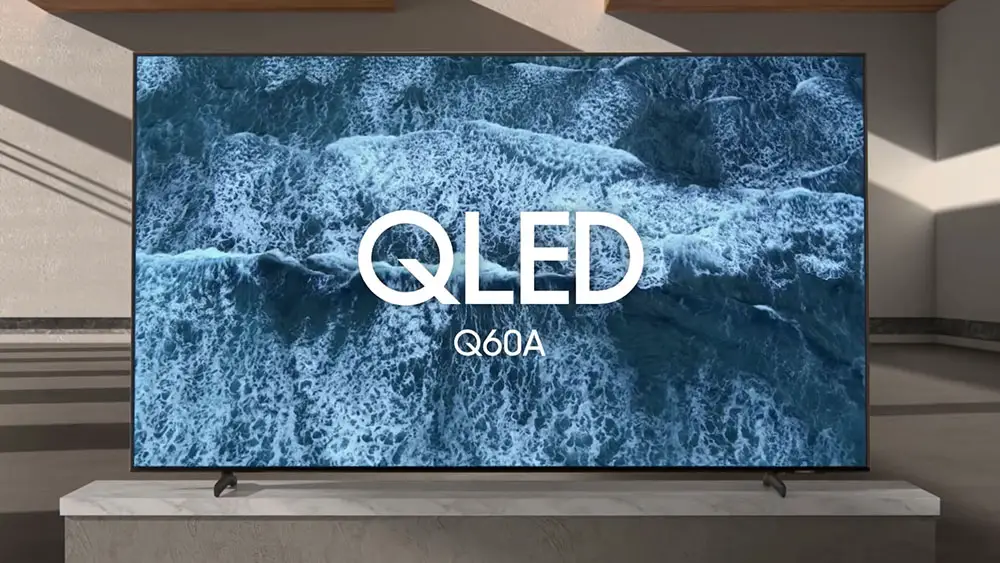
For more reviews you can check our dedicated 4K LED LCD TV reviews list or even look at our Product Reviews Table where you can find the brand and specific product you are looking for.
Cheapest Places to Buy :
*We are a reader-supported website. When you buy through links on our site, we may earn a small affiliate commission at no extra cost to you. Home Media Entertainment does not accept money for reviews.*
Hey. Thanks for the honest review of this TV. For me personally the viewing angle of a TV is quite important. It’s important to see where ever you are sitting. My mum has an old TV and Samsung is always our choice when it comes to phones or Tv’s so I was considering this brand. What do you think?
I would say that if viewing angles is important to you then the Q60A is not very ideal. OLED has the best viewing angles possible but if you cannot afford one then either a TV with an IPS panel or a TV with a VA panel with with some added ultra viewing angle technology are your best bets.
This is an extremely comprehensive review of the Samsung Q60A.
I think for the money that this is an excellent TV. I haven’t upgraded my TV in years, but have been considering doing so lately. I did not want to pay big money for a top of the range model, so this is exactly the one that would appeal to me.
Even the solar panel to recharge the remote fascinates me. Yes I am easily amused and easy pleased lol.
Thanks for all the great information.
Hey there. If you don’t have very high expectations concerning image quality then the Q60A is more than ok. It all depends what you expect out of it.
Hi,
Thanks for the comprehensive review. Would you say that this “low budget QLED” is worth the price difference compared to the Samsung LCD range such as the TU6900 / TU700 series? From reading both reviews on your website, they seem to have similar limitations (brightness, viewing angle, not giving the full HDR experience) but does the QLED give a noticeably higher performance?
Hello Antoine. It really depends on how much of a difference in price we are talking about as their price is not the same across all regions. But in general the Q60A is better than the TU7000 in almost every way. Especially in color reproduction and brightness performance the Q60A is crushing the TU7000 so if you are torn between the two my suggestion is to go for the Q60A. It offers a much better HDR experience than the TU7000.
Excellent detailed review thank you.
I know this is subjective to a great extent, but would you suggest using a soundbar or do you think the TV sound itself would suffice for everyday tv?
Hey Phil. For everyday TV it can be just fine. But if you want to watch movies and you can afford a budget to get a soundbar then I would definitely recommend it.
Hi,
I bought and returned LG oled c1 77” tv because of reflection issues in my garden room which has double doors on each side (not directly opposite). Comparing to my 6 years old Samsung ue65mu6400 I personally can’t tell the difference between the two. Can you please advise me if this tv would have better pitcher quality than my mu6400? And would the Q60A be good for the garden room which gets a lot of light? I am looking at 85” screen. Thanks.
Hello Shish. Just to be clear, you are looking for an 85″ TV for a bright room?